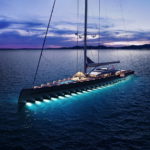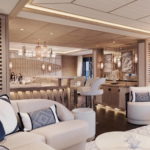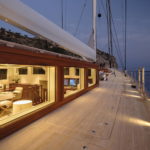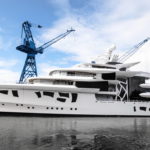Current environmental discussions about plastics and power technologies have an impact on the yacht industry, too. However, HANSA’s annual superyacht report shows, the main trends remain as strong as before, yet to peak. By Nick Jeffery
Environment-friendly is de rigueur for today’s new superyachts, even though it’s a bit of an Emperor’s New Clothes situation[ds_preview] as superyachts are all really rather bad for the environment, both in energy used during construction and in operations. Everybody in the industry is encouraged to play along and commend owners on what great things they are doing for the oceans. Most turn a blind eye to the fact that the original wealth to purchase the yacht, in certain cases, might have been amassed while causing havoc extracting oil, gas or coal from planet Earth, some owners perhaps even guilty of supporting campaigns to relax anti-pollution regulations in their industry.
The 106m »Black Pearl«, with DynaRig, built by Oceanco, and 143m Sailing Yacht »A«, by Nobiskrug (HANSA 09/2017), are fine examples of voluminous oligarch-owned award-winning superyachts with the potential to harness energy from the wind.
Linked to the environment-friendly trend, explorer yachts, occasionally venturing to remote destinations to do good, are a breed that are coming of age, purposeful lines evoking a commercial workboat feel. It is a bit like driving a hybrid Land Rover Defender (launching 2020) in Monaco, suggesting that »we drive off-road in the countryside at weekends, sourcing organic-produced Prosecco from remote vineyards while testing the soil for signs of fertilizer pollution.«
Niches in combination
One opinion is that if people are going to commission a big superyacht anyway – and nobody is telling potential owners that not building is the best for the environment – then it is better the industry guides prospects towards a vessel with green credentials.
A combination of wind-powered, hybrid, explorer-researcher – conceding they need helicopters and submarines to assist with research, operations and safety – is therefore one niche for the future, with efficient hull forms. The Cousteau Society was ahead of its time with the diesel-turbosail hybrid 31 m »Alcyone«, designed by André Mauric and launched in 1985 (with this author in the design team). 35 years after designing »Alcyone«, Mauric has just signed an exciting new contract for two 136m wind-powered roro cargo transport vessels for »Neoline«, partnered with Renault.
On the explorer superyacht front there are endless projects on the drawing board, from a 79m SWATH to be built by Abeking & Rasmussen, chartered out for private expeditions (with garages for cars of guests who are accommodated in suites of 170-240 m2), to a 115-Oceanographic Research Vessel to be built at Lloyd Werft, both still semi-confidential. Residences are offered with a 10–12-year lease, in partnership with a Hamburg shipping company, with an option to purchase, based on the residual value afterwards.
Environmental concerns
Today’s younger generation of wealthy entrepreneurs is concerned about the environment and also often said to be more into destination experiences than out-and-out ownership so chartering of flexible specialist vessels might well work with the possibility to combine deep sea exploration with comfort. Ocean Talks, hosted by Boat International at the Royal Geographical Society, London, saw the likes of EYOS Expeditions explaining how they tailor expeditions and Alan Jamieson, Chief Scientist of Five Deeps Expedition, describing discovering new species in the ocean’s deepest points – the »Triton« submarine was classed to go to »unlimited depth« by DNV GL since it could easily manage 8,500m in the Mariana Trench. Owners of superyachts were encouraged by Ocean Talks to offer off-peak time to dedicated marine scientists, whose requirements are quite modest (eg: »two berths/cabins for a week in the Western Mediterranean«). Bringing the family aboard for a holiday, enjoying the water toys, while scientists collect samples, then all gathering together around a fire-pit on deck for an evening debrief is quite an attractive proposition, no doubt children sharing the day’s discoveries with influencer schoolfriends around the globe quicker than a PR agency.
Some of the finds will be disappointing, judging by the amount of plastic found at sea. David Attenborough was recently quoted as saying: »the thing that is so galling about plastic pollution in particular is that it is so utterly unnecessary. The plastic in our oceans ought never to have got there in the first place – much of it perhaps ought not to have even been manufactured at all. And yet it is there, in unbelievable quantities, causing untold harm to marine wildlife. And, of course, once it’s in the sea, it doesn’t really break down properly – it remains there for decades or even centuries. So, unless we get to grips with this quickly, we will soon find our oceans completely dominated by plastic. It’s a prospect that hardly bears thinking about.« Amanda Keatley, author of Plastic Game Changer, was an Ocean Talks speaker and produces cards and posters with tips for using less plastic – these should be placed in every cabin next to water jugs in place of the still-popular single-use plastic Evian bottles.
Clients expect sustainability
Designers are outspoken on the various trends they see. Philippe Briand notes that clients are already expecting sustainability and »the industry has to be inventive to follow up the progress of society in this matter«. Wally’s Luca Bassani has noted a demand for »volume, volume, volume! This is the main design trend: trying to offer the maximum space and comfort.« Bassani also sees »the market is looking for long-term products and no more boats to be replaced every two or three years. Shipyards must follow this trend and design products which could be used by the same owner for a longer period. It is a matter of quality and functionality.« Ciarmoli Queda Studio of Milan, who won a World Superyacht Award for the interior of the 106m »Dream«, echo this: »We believe that yacht interior Design (CQS’s capital ‘D’) is moving closer to the goal for which Design was originally born. A new sense for luxury with a close eye on comfort is achieved through the use of ultimate performance materials and maximum functionality.«
A more relaxed holiday feel
London-based Vickers Studio, established just five years ago, notes a definite »move towards a more relaxed holiday feel. With Ibiza becoming very much ‘the place to go’ there is an awareness that ‘luxury’ is about being able to feel comfortable in your bathing suit, walking through your interior, rather than in a jacket and tie«. John Vickers adds: »For exterior yacht design there is a move in the industry to a more sustainable, environmentally conscious yachting. Due to the length of time it takes to build a yacht it can look like progress is a little slow, however there is a perceptible trend towards reducing carbon emissions, and having less of an impact on the marine environment. The simplest way to reduce carbon emissions is to create longer thinner yachts and of course add masts and sails« – the latter comment was most likely gleaned from Espen Oeino’s »designing environmentally-friendly superyachts« popular presentation at the DNV GL event, which also saw Marc Van Peteghem (VPLP) demonstrate his OceanWings system.
Michael Leach Design (MLD) – creating multiple-award-winning yachts from the New Forest – who launched the 93m »Lady S« and 110m »Anna« in the past year, note, »the trend for beach club areas on any deck is still strong, highlighting the preferred usage of seamless indoor/outdoor living areas becoming a lot more utilitarian. IMAX cinemas and AV/IT evolution is at the forefront with the first C-Seed screen being incorporated onto Lady S along with the first ever IMAX cinema (two-decks high). Firepits remain in fashion and it is becoming increasingly popular that they feature on multiple decks – giving owners and guests the flexibility to chill out on the sun deck under the stars or enjoy after dinner drinks on the owner’s deck aft«. MLD also recognise, »the surge of the sustainability and ecology focus with regards to numerous functional aspects of a yacht is very much at the forefront of clients’ minds«, adding that there is a trend back to more manageable-sized yachts, »sub 90 metres«!
Winch Design, one of the largest design organisations, overlooking the Thames, who have three superyacht designs launching in 2019, state: »The superyacht industry is constantly evolving, and clients are seeking new technologies, expecting more from their yachts as well as changing how they’re using their yachts. We’re noticing that clients are choosing to spend much longer periods of time on their yachts. Some are even treating them as their permanent residence and moving their floating home around the world.
Therefore, the interiors are now treated as, and function as, dream homes at sea and are not just for holidays. Owners are also becoming more adventurous and wanting their yacht to be a unique expression of themselves. Some of the clients we work with are very experienced and want to break the mould. The 80m »Excellence«, with her wrap-around mirrored glass, is a perfect example of this unique, breakthrough approach to design.« Winch Design have experienced changes in the market »noticing that clients are younger, with their wealth not coming from traditional industries such as oil, gas and construction, but from e-commerce and fin-tech platforms. Younger clients also have a taste for adventure, and there is a greater interest in explorer yachts, vessels which are more durable than traditional superyacht designs, and equipped with toys and tenders for exploration in harsh climates.
These yachts have a higher crew capacity and can be out at sea for many months. Clients are much more environmentally conscious and invested in sustainability. Not only have we seen a resurgence in clients requesting sailing yachts, but many are enquiring about hydrogen fuel cell technology and beginning to think about incorporating this into their designs, something which Winch Design is also keen to explore.«
Sail market picking up?
The sailing yacht market is still considered »pretty dire« by Lymington-based Malcolm McKeon – who nevertheless launched one sail yacht this year and has two bid packages out to tender – but »picking up«. McKeon believes the industry »shot itself in the foot« in a way as cruisers started to join the fun regattas and in turn the boats got racier and more expensive with lightweight interiors and carbon sails and rigs. Depreciation is quite high being some 50%, over three years, for say a €20m 34m, although »at least with a new yacht you know where you are as with a second-hand one you might pay the purchase price again in the first year fixing things«. McKeon would like to see the market »get back to building some heavier cruisers too« and believes »the lack of second-hand cruisers might help regenerate that segment«.
He does note that prospective owners, new to yachting, comparing sail and power, »see they get more volume for their money with a motor yacht compared to a racer« and feels that sailing multihulls could take off, for which he has a number of designs ready to go.
Dykstra, celebrating its 50th anniversary this year, recently launched the classic-styled 56m ketch »Aquarius« – built at Royal Huisman with interior by Mark Whiteley and project management by Godfrey Cray – that kicked off her racing life with the St Barths Bucket regatta. Gerard Dykstra, always keen to promote the use of wind, even in commercial vessels, also sees the business he founded having a 36m building at Baltic Yachts, noting that »yachts are getting bigger and bigger and, fortunately, also a lot greener and owners more environmentally conscious«.
The market is strong, particularly in the USA, YACHTS Europe’s Top 100 (qualifying length 85m) listing eleven new entries: »Tis« (111m Lürssen), »Anna« (110m Feadship), »Bravo Eugenia« (109m Oceanco), FB 275 (108m Benetti), »Samar« (108m Benetti), FB 277 (107m Benetti), »Dream« (106m conversion) »Madsummer« (95m Lürssen), »Lady S« (93m Feadship), »Dreamboat« (90m Oceanco), »Lonian« (87m Feadship).
»Billionaires are getting younger«
Brokerage houses polled were reticent about sharing information however Jim Evans, CEO of SuperYachtsMonaco, confirms that buyers are eco-friendly on every level, commendably rejecting single-use plastics, and: »the demographic has changed in that it is a younger client base now compared to that of 10 years ago. Billionaires are getting younger and therefore the interests of younger owners and guests are being reflected in the user-profile of the yachts and so design follows this trend. Specifically, the capability of yachts in terms of autonomy is more important nowadays and also the activities / toys offered on board become more and more varied. The current market is very fickle and we find a mismatch with sellers firmly believing it to be a sellers’ market but buyers equally convinced it is a buyers’ market – the number of transactions is thus down because it is presently so difficult to close the gap in those buyer/seller expectations.«
One significant deal where buyer and seller agreed on a price was the announcement in July 2019 that USA’s MarineMax had acquired Fraser Yachts – who claim to have had a 24% of brokerage market share for the past five years – from Azimut Benetti Group.
Fitting out companies are easily overlooked, as one studies global order books, however they do give an indication of the fast-changing market too. While Boutsen Design and Sabrina Monte Carlo grow locally in and around Monaco »World Capital of Yachting«, Glancy Fawcett has expanded its showroom in Manchester – dubbed the ›Creative Capital of the UK (outside London)‹. Glancy Fawcett’s CEO Rob Bieniasz finds that clients like to spend a day, or even two, away from distractions making selections, benefiting from GF’s Uniquely Yours service, or visiting the new Limited Editions inner sanctum show space, where unique art pieces by leading artists are displayed – gallery meets shop. Bieniasz says: »The big change in the last six months is how people now consider the usage of plastics, recycling and the relationship to the sea. We’re looking closely into our raw materials and ensuring packaging is reduced and biodegradable. Glancy Fawcett places a strong emphasis on the provenance of its products and offers sustainable products from Abyss, Sieger by Fürstenberg, Guaxs, Hefel and Grant MacDonald, to name a few«.
Network has been launched
Sustainability has emanated from the Yacht Club de Monaco (YCM) and Prince Albert II Foundation (fpa2.com) since before it became fashionable. This year the Sustainable Yachting Network has been launched getting the two working closer than ever, along with Monaco Yacht Show, Cluster Yachting Monaco, and »Ramoge Agreement« (protecting the Mediterranean Sea since 1976). YCM’s clubhouse facilities prove ideal for corporate events, peaking during Monaco Yacht Show. La Belle Classe Superyachts Environmental Symposium is coming up for its 10th edition, while the sixth edition of the Monaco Solar & Energy Boat Challenge attracted a record entry of 34 teams from 14 countries. Nobiskrug – whose 80m »Artefact« recently launched – and Torqeedo – »electric mobility on the water« – were new brands to the event this year joining Energy Observer, showing the potential of hydrogen. The average age was considerably less than that of YCM members, as the young drive the quest for clean energy – with not a single-use plastic water bottle in sight, but plenty of glasses being refilled with beer, or Prosecco, keeping the cross-fertilization of ideas flowing internationally.
Nick Jeffery

























